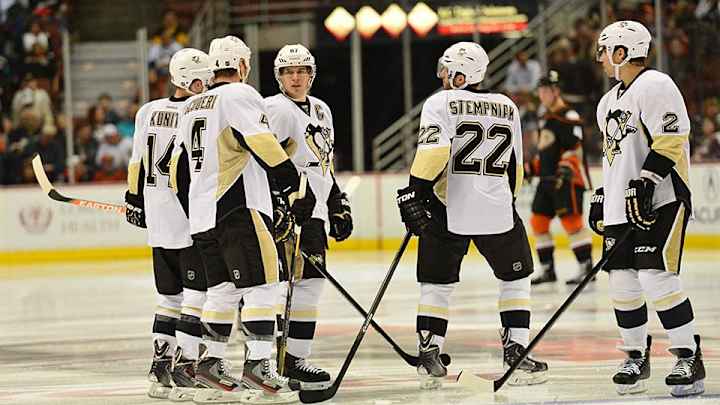From the bottom up: Remaking the Pittsburgh Penguins

When it came time to discuss the Penguins, the pundits on Sportsnet’s July 1 Signing Season show fell back on a familiar trope: Who should Pittsburgh acquire to play with Sidney Crosby?
Ever since Crosby’s 2005 debut, the question has obsessed fans, media and Penguins management. With dedicated sidekick Chris Kunitz—the winger with whom Crosby has played over 80% of the time during the last two seasons—still viewed by many as a third wheel, the search continues for Sid the Kid’s perfect righthand man.
Had Pittsburgh signed a top winger on July 1, it would not only have helped Sportsnet’s ratings, but it would have also gone a long way toward soothing fans in the midst of an otherwise unsettling off-season.
The trouble started on June 6—23 days after the Pens had blown a 3–1 series lead in losing to the Rangers in the second round of the playoffs—when the team hired general manager Jim Rutherford, who was coming off five uninspiring years as the GM in Carolina, which has reached the playoffs only once since winning the Stanley Cup in 2006. After firing coach Dan Bylsma, Rutherford and his bosses proceeded to bungle the search for Bylsma’s replacement to the point of hiring Mike Johnston, a man who wasn’t even on their original shortlist. By the time Rutherford shipped star winger James Neal off to the Predators in exchange for PatricHornqvist and Nick Spaling on June 27, some fans may have been willing to go back to the regime's old bosses.
But a funny thing has happened. Since the dust from free agency has settled, the Neal deal no longer seems to signal a new era of mediocrity. Instead, it has revealed a specific strategy. Under Pittsburgh’s new leadership, Sidney Crosby’s line isn’t a perennial problem, it’s the template for a solution.
Just looking at the statistics, the Penguins' real failing last year jumps off the page: They ranked 16th in the league with a 50.2% even-strength Fenwick score, putting their possession game on par with such middling teams as the Coyotes and the Predators, and well behind the league-leading (and Cup-winning) Kings (56.7%).
In this department, Pittsburgh’s top six forwards were not so much the problem as the shining example beside which the real problem—the rest of the forwards—became starkly evident. Advanced stats guru Tyler Dellowlaid the Penguins’ shortcomings bare in March, when he (accurately) predicted which teams were real Cup contenders (spoiler alert: the Pens weren’t one of them). At the time, Pittsburgh’s top six forwards were outscoring opponents at an almost 3:2 clip. For the bottom six, that ratio was flipped.
Rutherford’s strategy for fixing this hasn’t so much been to bolster the bottom half as to erase the traditional top six/bottom six divide completely. His first move—trading Neal for Hornqvist and Spaling—typified this mentality. He parted with the team’s best winger for two forwards whose odd skill sets allowed them to play all over Nashville’s lineup.
Hornqvist is a modern Tomas Holmstrom, fearless and gritty in front of the net. But compared to Neal, Hornqvist’s tools are more Fisher Price than Black & Decker. He can’t skate, or score from even a moderate distance, and he will often enter the offensive zone by chasing his own soft, harmless shot, hoping to force a cover-up whistle.
The Red Wings successfully made Holmstrom into a sidekick for PavelDatsyuk, figuring that if no one could keep up with the crafty Russian there should at least be a solid object in front of the net off of which he could bank shots.
Rutherford also bought low on several free agents, handing out a series of affordable one-year deals—lack of star power, after all, was not the reason why the Penguins hadn’t been back to the Stanley Cup finals since 2009. They now boast five players who have caddied for stars in the past: Hornqvist, Kunitz, Blake Comeau, Steve Downie and Pascal Dupuis. With trade-deadline acquisition Marcel Goc centering the third line, Pittsburgh can follow the skilled-center-plus-crease-crasher model with their top three lines—Crosby with Kunitz; Malkin with Hornqvist; and maybe Goc with Downie. (No one will ever mistake Goc for Malkin, but the underrated German has offensive talent.)
The risk is that making a habit of trading skill for grit will leave the Penguins worse-off in the long run. Spaling, for one, is the exact type of possession-poor penalty-kill specialist who tripped the Penguins up in the first place (see: Tanner Glass and Craig Adams). And not everyone is capable of playing with Crosby and Malkin, so someone will get the short end of the stick.
But Rutherford’s strategy is cheap and relatively low-risk: Goc, Comeau, and Downie will just cost $2.9 million total with no commitment after this season. In a world in which Dave Bolland gets a five-year, $27.5 million deal, that’s a nice arrangement.
Bargain hunting similarly allowed Rutherford to cheaply bring in defenseman Christian Ehrhoff while letting Matt Niskanen and Brooks Orpik sign for funny money with the Capitals. And the signing of Ehrhoff may also go a long way toward affecting a more even Pittsburgh attack.
Last year’s second 5-on-5 unit, which was led by Malkin, Neal and Orpik, certainly had more star power than the group that will be led by Malkin, Hornqvist and Ehrhoff next season. But the new unit doesn’t feature an obvious weakness (the slow-footed Orpik) on which other teams can focus. It’s also nearly a carbon copy of the first unit, led by Crosby, Kunitz and Letang.
That’s the new Penguins: more homogeneous, less flashy, but—most importantly for a team of elite talent itching for a second Stanley Cup—better.
